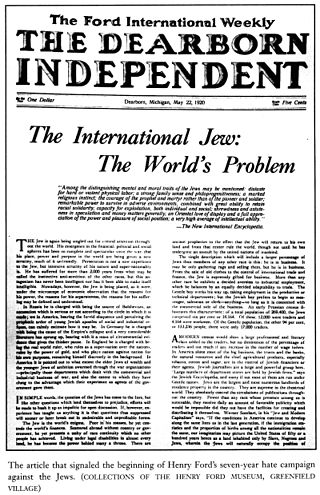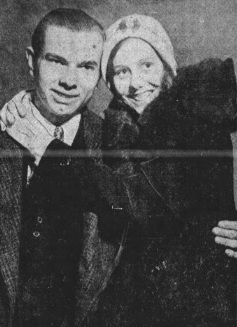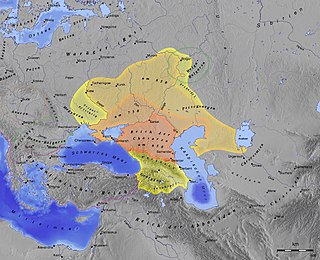Christian Identity is an interpretation of Christianity which advocates the belief that only Celtic and Germanic peoples, such as the Anglo-Saxon, Nordic nations, or people of the Aryan race and people of kindred blood, are the descendants of the ancient Israelites and are therefore God's "chosen people". It is a racial interpretation of Christianity and is not an organized religion, nor is it affiliated with specific Christian denominations. It emerged from British Israelism in the 1920s and began to take shape during the 1940s-1970s. Today it is independently practiced by individuals, independent congregations, and some prison gangs.

The Dearborn Independent, also known as The Ford International Weekly, was a weekly newspaper established in 1901, and published by Henry Ford from 1919 through 1927. The paper reached a circulation of 900,000 by 1925, second only to the New York Daily News, largely due to a quota system for promotion imposed on Ford dealers. Lawsuits regarding antisemitic material published in the paper caused Ford to close it, and the last issue was published in December 1927. The publication's title was derived from the Detroit suburb of Dearborn, Michigan.

The Zionist occupation government, Zionist occupational government or Zionist-occupied government (ZOG), sometimes also referred to as the Jewish occupational government (JOG), is an antisemitic conspiracy theory claiming Jews secretly control the governments of Western states. It is a contemporary variation on the centuries-old belief in an international Jewish conspiracy. According to believers, a secret Zionist organization is actively controlling international banks, and through them governments, in order to collude against white, Christian, or Islamic interests.

Gerald Lyman Kenneth Smith was an American clergyman, politician and organizer known for his populist and far-right demagoguery. A leader of the populist Share Our Wealth movement during the Great Depression, afterward he became known for far-right causes including the Christian Nationalist Crusade, which he founded in 1942. He founded the America First Party in 1943 and was its 1944 presidential candidate, winning fewer than 1,800 votes. He was a preeminent antisemite and a white supremacist.

Elizabeth Eloise Kirkpatrick Dilling was an American writer and political activist. In 1934, she published The Red Network—A Who's Who and Handbook of Radicalism for Patriots, which catalogs over 1,300 suspected communists and their sympathizers. Her books and lecture tours established her as the pre-eminent female right-wing activist of the 1930s, and one of the most outspoken critics of the New Deal, which she referred to as the "Jew Deal". In the mid-to-late 1930s, Dilling expressed sympathy for Nazi Germany.
The America First Party was an isolationist political party which was founded on January 10, 1943. Its leader, Gerald L. K. Smith, was the party's presidential candidate in the 1944 U.S. presidential election.

The International Jew is a four-volume set of antisemitic booklets or pamphlets originally published and distributed in the early 1920s by the Dearborn Publishing Company, an outlet owned by Henry Ford, the American industrialist and automobile manufacturer.
This is a list of topics related to racism:

Wesley A. Swift was a minister from Southern California who was known for his white supremacist views and was a central figure in the Christian Identity movement from the 1940s until his death in 1970.
Dewey H. "Buddy" Tucker is an American minister from Dandridge, Tennessee, and former pastor of the "Temple Memorial Baptist Church" in Knoxville, Tennessee. He is a white nationalist, anti-Semitic, former Baptist and founder of the now defunct group "National Emancipation of our White Seed".

The Khazar hypothesis of Ashkenazi ancestry, often called the Khazar myth by its critics, is a largely abandoned historical hypothesis that postulated that Ashkenazi Jews were primarily, or to a large extent, descended from Khazars, a multi-ethnic conglomerate of mostly Turkic peoples who formed a semi-nomadic khanate in and around the northern and central Caucasus and the Pontic–Caspian steppe. The hypothesis also postulated that after collapse of the Khazar empire, the Khazars fled to Eastern Europe and made up a large part of the Jews there. The hypothesis draws on medieval sources such as the Khazar Correspondence, according to which at some point in the 8th–9th centuries, a small number of Khazars were said by Judah Halevi and Abraham ibn Daud to have converted to Rabbinic Judaism. The scope of the conversion within the Khazar Khanate remains uncertain, but the evidence used to tie the subsequent Ashkenazi communities to the Khazars is meager and subject to conflicting interpretations.
Howard Rand, also known as Howard B. Rand and Howard Benjamin Rand was a lawyer, inventor, and three-time candidate for Massachusetts state office on the Prohibition Party ticket, He headed the former Anglo-Saxon Federation of America, a British Israelist group. He served from 1937 to 1968 as editor of its affiliate Destiny Publishers, which put out Destiny magazine.
National Gentile League, Inc., also known as the American Gentile League, was an American antisemitic organization active in the 1930s. It was incorporated by B. E. Clark, W. N. Fox and M. L. Burnett in 1934, but it was most notably headed by Donald Shea of Maryland. Lois de Lafayette Washburn acted as the executive secretary for the organization.
William Potter Gale was an American political activist who was involved with several white supremacist groups, including Christian Identity and the Posse Comitatus. He had connections to the Church of Jesus Christ–Christian, Aryan Nations, the sovereign citizen movement, and the militia movement.
The Christian Defense League was founded as a white supremacist activist organization in California, and it later moved to Louisiana. According to the Anti-Defamation League, it also had a paramilitary function.
Zionist antisemitism or antisemitic Zionism refers to a phenomenon in which antisemites express support for Zionism and the State of Israel. In some cases, this support may be promoted for explicitly antisemitic reasons. Historically, this type of antisemitism has been most notable among Christian Zionists, who may perpetrate religious antisemitism while being outspoken in their support for Jewish sovereignty in Israel due to their interpretation of Christian eschatology. Similarly, people who identify with the political far-right, particularly in Europe and the United States, may support the Zionist movement because they seek to expel Jews from their country and see Zionism as the least complicated method of achieving this goal and satisfying their racial antisemitism.
Bertrand Lewis Comparet (c1900-1983) was an influential figure in the development of the Christian Identity movement.
Conrad Gaard was a Anglo-Israel minister and a key figure in the emergence of Christian Identity from British Israelism. He was one of the first to incorporate the serpent seed doctrine into Christian Identity teaching.
James K. Warner (b.1939) was an early recruit to George Lincoln Rockwell's American Nazi Party (ANP) as part of the core of the party and national secretary. He later became involved with the National States' Rights Party (NSRP). After moving to Los Angeles, he was converted to Christian Identity by Wesley Swift and started the New Christian Crusade Church. Warner succeeded Richard Girndt Butler as leader of the Christian Defense League. He eventually moved both the New Christian Crusade Church and the Christian Defense League to Louisiana. Warner later became the Louisiana Grand Dragon of David Duke's Knights of the Ku Klux Klan.





